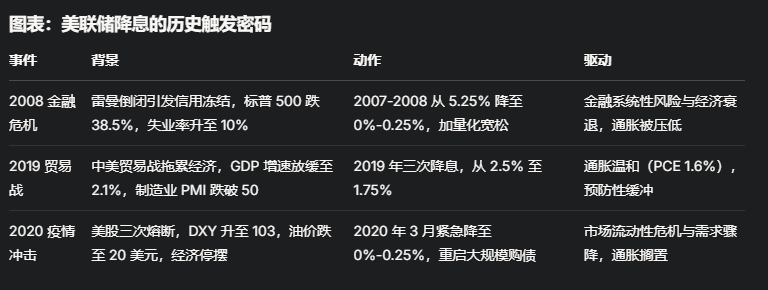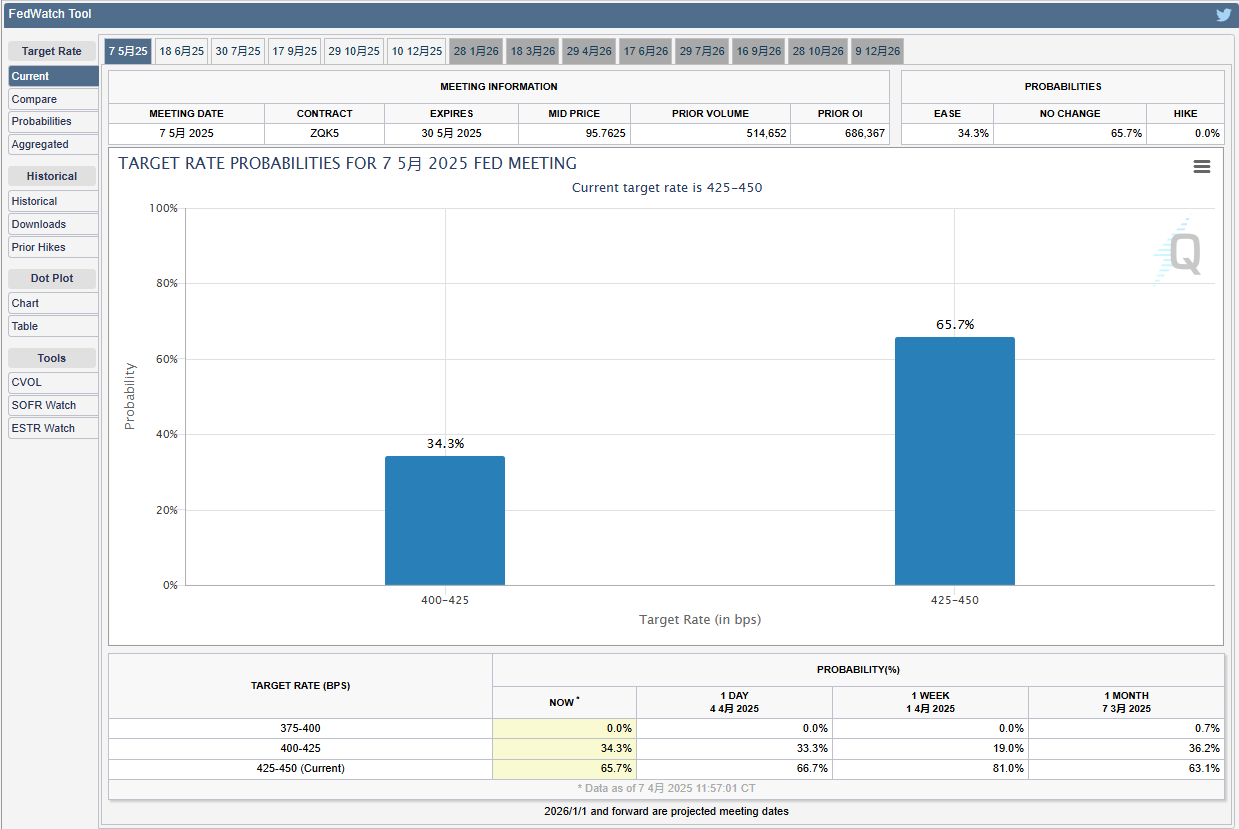In April 2025, the tariff stick of the Trump administration once again shocked global markets. U.S. stocks plummeted, and crypto assets bled heavily, with Bitcoin dropping over 10% in two days and Ethereum once plunging 20%. The liquidation amount in 24 hours reached as high as $1.6 billion. Investors were anxious and turned their attention to the Federal Reserve, hoping for interest rate cuts to save the market. However, the silence from the Federal Reserve was unsettling: where exactly is the critical point for rate cuts? Under the dual pressure of inflation concerns and economic strain, when will the Federal Reserve ease its policies? This is not just a data game, but a contest of market confidence and macroeconomic strategy.
Historical Reflection: The Trigger Codes for Rate Cuts
The Federal Reserve's decisions to cut interest rates have never been arbitrary but rather well-considered choices made during crises or economic turning points. Looking back at key moments in recent years, we can extract the logic behind rate cuts from historical scripts to provide a reference for the current tariff crisis. Below are detailed analyses of three landmark rate cuts, revealing the environments and motivations behind them.

2008 Financial Crisis
- Emergency rescue background of systemic collapse: In September 2008, the collapse of Lehman Brothers ignited a global financial tsunami, exposing the fragility of the U.S. real estate bubble through the subprime mortgage crisis. The interbank credit market froze, the S&P 500 fell by 38.5% for the year, and the Dow Jones index plummeted 18% in a single week in October. The unemployment rate surged from 5% at the beginning of the year to 7.3% by the end, eventually peaking at 10% the following year. The VIX panic index soared above 80, and the dollar LIBOR-OIS spread skyrocketed from 10 basis points to 364 basis points, indicating a near collapse of interbank trust.
- Rate cut actions: The Federal Reserve first cut rates by 50 basis points in September 2007, lowering them from 5.25% to 4.75%. It then accelerated its actions in 2008, cutting rates twice in October for a total of 100 basis points, and further lowering them to the ultra-low range of 0%-0.25% in December, while also launching quantitative easing (QE) to inject trillions of dollars in liquidity into the market.
- Trigger codes: Systemic financial risks (bank failures, credit freezes) and economic recession (consecutive negative GDP growth). Inflation pressures were quickly masked at the onset of the crisis, with core PCE dropping from 2.3% to 1.9%, creating room for rate cuts. The Federal Reserve prioritized financial stability and employment, making a "zero interest rate" inevitable.
2019 Trade War
- Background of preventive rate cuts as a buffer strategy: From 2018 to 2019, the U.S.-China trade war escalated, with the U.S. imposing tariffs on Chinese goods, putting pressure on global supply chains. U.S. GDP growth slowed from 2.9% in 2018 to 2.1% by mid-2019, and the manufacturing PMI fell below 50 to 47.8, indicating a contraction in economic activity. The S&P 500 dropped 19% at the end of 2018, and the yield curve for 10-year and 2-year U.S. Treasury bonds inverted, signaling a recession warning. Corporate investment confidence declined, but the unemployment rate remained stable at a low of 3.5%.
- Rate cut actions: In July 2019, the Federal Reserve cut rates by 25 basis points, lowering them from 2.25%-2.5% to 2%-2.25%. In September and October, it cut rates again by 25 basis points each time, ultimately lowering them to 1.5%-1.75%, for a total annual reduction of 75 basis points.
- Trigger codes: Signs of economic slowdown (manufacturing contraction, declining investment) and global uncertainty (trade war), rather than a full-blown recession. Inflation was moderate, with core PCE maintaining around 1.6%, below the 2% target, providing room for preventive rate cuts. The Federal Reserve aimed to buffer external shocks and avoid a hard landing for the economy.
2020 Pandemic Shock
- Decisive intervention amid a liquidity crisis: In March 2020, the global spread of COVID-19 led to three circuit breakers in U.S. stocks on March 9, 12, and 16, with the S&P 500 experiencing a maximum single-day drop of 9.5% and the VIX panic index soaring to 75.47. A dollar liquidity crisis emerged, with investors selling assets for cash, causing the DXY to surge from 94.5 to 103, a three-year high. Oil prices collapsed, with WTI falling below $20, and the global economy faced the risk of a shutdown.
- Rate cut actions: On March 3, 2020, the Federal Reserve urgently cut rates by 50 basis points to 1%-1.25%; on March 15, it cut rates again by 100 basis points to 0%-0.25% and restarted large-scale QE, rapidly expanding the scale of bond purchases to hundreds of billions of dollars.
- Trigger codes: Exhaustion of liquidity in financial markets (U.S. Treasury sell-offs, credit market freezes) and the risk of economic shutdown (demand plummeting due to lockdown measures). Inflation was overlooked at the onset of the crisis, with core PCE dropping from 1.8% to 1.3%, as the Federal Reserve prioritized stabilizing the market and preventing systemic collapse.
These cases reveal that the Federal Reserve's rate cuts typically revolve around three core conditions:
- Low or controllable inflation: In 2008 and 2020, inflation was suppressed by the crisis, while in 2019, inflation was below target, paving the way for rate cuts.
- Significant economic strain: Whether recession (2008), slowdown (2019), or shutdown (2020), economic weakness is a key driver.
- Financial market collapse: Systemic risks such as credit freezes (2008) and liquidity crises (2020) forced the Federal Reserve to act decisively.
Current Predicament: The Tug-of-War Between Inflation and Turmoil
On April 7, 2025, global markets fell into panic due to Trump's tariff policies. U.S. tech stocks suffered heavy losses, with the S&P 500 at one point dropping over 4.7%, and the crypto market also declined. However, Federal Reserve Chairman Powell stated calmly last Friday: "The economy is still in good shape, and we will not rush to respond to market turmoil." The core PCE inflation rate remained at 2.8%, above the 2% target, and tariffs could further push up prices, casting a shadow over the prospects for rate cuts.
At the same time, market signals were exacerbating tensions. According to Tradingview data, the bond volatility index (MOVE Index) broke through 137 points on April 8, marking a "seven-day rise" and approaching the "critical line" of 140 points predicted by Arthur Hayes. Hayes had warned: "If the MOVE Index rises, leveraged Treasury and corporate bond traders will be forced to sell due to increased margin requirements, which is a market that the Federal Reserve is determined to defend. A breach of 140 is a signal for liquidity injection after a collapse." The current index is just a step away from this threshold, indicating that pressure is building in the bond market.

Goldman Sachs analyst Lindsay Matcham pointed out that the widening credit spread could be another trigger for the Federal Reserve to act. If the high-yield bond spread rises to 500 basis points, difficulties in corporate financing and a weak job market may emerge, forcing Powell to shift to easing as he did in 2018. Currently, the high-yield bond spread has reached 454 basis points, not far from the warning line, and the market is sensing the smell of risk.
External Voices: Consensus Amid Disagreement
There is significant divergence in the market's judgment on the timing of the Federal Reserve's rate cuts. BlackRock CEO Larry Fink poured cold water on the idea: "The likelihood of the Federal Reserve cutting rates four or five times this year is zero; rates may not only not fall but could rise." He believes Powell's tough stance stems from stable non-farm data and inflation concerns, making it difficult to exhaust policy "bullets" in the short term. In contrast, Goldman Sachs predicts that if there is no recession, the Federal Reserve may cut rates three times in a row starting in June to 3.5%-3.75%; if a recession is triggered, the cut could reach 200 basis points.
Anxiety is also evident within the Federal Reserve. On April 8, Chicago Fed President Goolsbee stated: "The hard data of the U.S. economy is performing exceptionally well, but tariffs and countermeasures may once again lead to supply chain disruptions and high inflation, which is concerning." This uncertainty puts policymakers in a dilemma: cutting rates could fuel inflation, while waiting could risk missing the window to save the market.
The Critical Point for Rate Cuts: Signals and Timing
Based on historical experience and current dynamics, the Federal Reserve may need one of the following conditions to manifest for rate cuts:
- Easing inflation: Core PCE falls to 2.2%-2.3%, and the effects of tariffs are proven to be controllable.
- Economic weakness: Unemployment rises to 5% or GDP growth significantly slows, revealing the impact of tariffs.
- Escalating financial turmoil: MOVE Index breaks through 140, or high-yield bond spreads exceed 500 basis points, accompanied by stock market declines of over 25%-30%.
As of now (April 7, 2025), CME's "FedWatch" shows a 54.6% probability of a 25 basis point rate cut in May, with market expectations slightly ahead. However, the bond market has not fully priced in a recession, with the 10-year Treasury yield fluctuating between 4.1%-4.2%, and a liquidity crisis has not yet emerged. The Federal Reserve is more likely to first utilize lending tools rather than immediately cut rates.

Future timing predictions:
- Short-term (May): If the MOVE Index breaks through 140 or the credit spread approaches 500 basis points, combined with further declines in the stock market, the Federal Reserve may cut rates by 25-50 basis points ahead of schedule.
- Medium-term (June-July): If the effects of tariffs become evident in the data, and if inflation falls and the economy slows, the probability of rate cuts will increase, potentially accumulating to a reduction of 75-100 basis points.
- Crisis scenario (Q3): If the global trade war escalates and the market fails, the Federal Reserve may urgently cut rates and restart QE.
The tariff crisis is like a stress test, testing the patience and limits of the Federal Reserve. As Hayes said, volatility in the bond market may be a "prelude" to rate cuts, while the widening credit spread could be the "trigger." Currently, the market oscillates between fear and anticipation, while the Federal Reserve waits for clearer signals. History has shown that every crash is a starting point for reshaping, and this time, the key to rate cuts may be hidden in the next leap of the MOVE Index or the critical breakthrough of the credit spread. Investors need to hold their breath, as the storm is far from over.
免责声明:本文章仅代表作者个人观点,不代表本平台的立场和观点。本文章仅供信息分享,不构成对任何人的任何投资建议。用户与作者之间的任何争议,与本平台无关。如网页中刊载的文章或图片涉及侵权,请提供相关的权利证明和身份证明发送邮件到support@aicoin.com,本平台相关工作人员将会进行核查。




